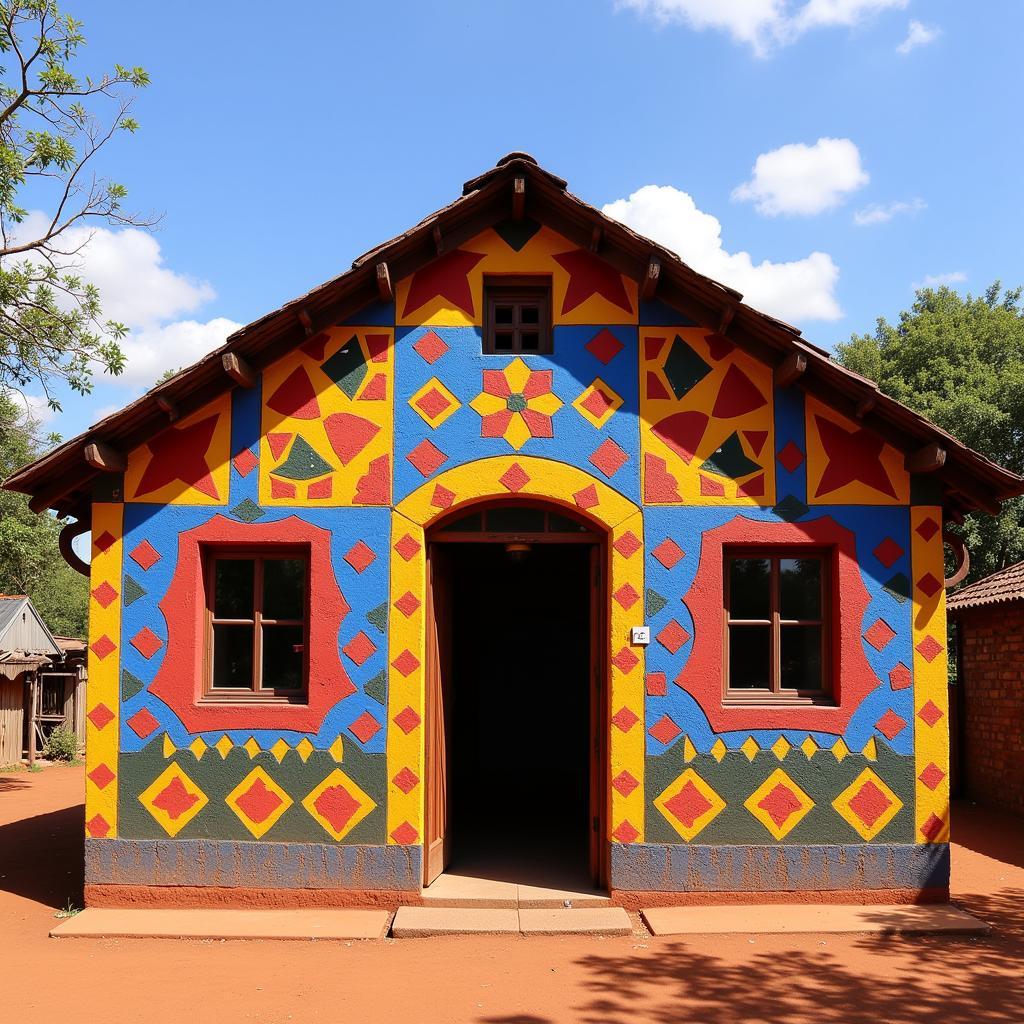All About African Paintings: A Rich Tapestry of Culture and Expression
African paintings are more than just aesthetically pleasing artworks; they’re vibrant narratives of history, culture, and spirituality. They offer a unique window into the diverse world of the African continent, showcasing its rich heritage and artistic traditions. From ancient rock art to contemporary canvases, African paintings offer a compelling journey through time and expression.
Exploring the world of African paintings involves understanding the diverse styles, materials, and symbolism unique to different regions and cultures. For instance, the bold geometric patterns of Ndebele art differ drastically from the intricate details found in Ethiopian religious iconography. This diversity is what makes the study of African art so fascinating. You can delve into captivating collections of African Ladies Based on Tilly Wilson Glass Painting for a glimpse into portraiture inspired by European techniques.
 Ndebele House Painting
Ndebele House Painting
Unmasking the Symbolism: Understanding African Art
The power of African painting often lies in its symbolism. Animals, plants, and natural elements often carry deep cultural and spiritual meaning, acting as storytellers within the artwork. Colors also play a crucial role, with specific hues representing different emotions, social statuses, or spiritual concepts. Understanding this symbolism unlocks a deeper appreciation for the artwork and the stories it tells. Whether it’s exploring African Art Paintings Pics or focusing on specific mediums like African Art Paintings on Canvas, the underlying symbolism offers a richer understanding of the continent’s cultural tapestry.
The use of natural pigments derived from plants, minerals, and earth adds another layer of meaning to these artworks, connecting them directly to the land and its resources. This intimate relationship with nature is a recurring theme in many African artistic traditions.
From Rock Art to Canvas: A Historical Overview of African Paintings
African painting has a long and rich history, dating back to prehistoric times. Ancient rock art found across the continent provides glimpses into the lives and beliefs of early humans. These paintings, often depicting animals, hunting scenes, and symbolic figures, offer valuable insights into the evolution of artistic expression and cultural practices. The journey through time continues with exploring African American Oil Paintings, reflecting the influence of Western techniques blended with African heritage.
Exploring Different Styles and Techniques
Over the centuries, diverse painting styles and techniques have emerged across the African continent. From the intricate miniature paintings of Ethiopia to the vibrant textile art of West Africa, each region has developed its own unique artistic language. The use of different materials, from natural pigments and dyes to contemporary acrylics and oils, further contributes to the rich tapestry of African painting. For those interested in specific themes, African Flowers Paintings provide a beautiful exploration of nature’s influence on art.
“African art is not a monolithic entity,” says Dr. Anika Kwame, a renowned art historian specializing in African art. “It’s a dynamic and evolving conversation between diverse cultures, traditions, and individual expressions.”
The Impact of Colonization and Globalization
The impact of colonization and globalization has also shaped the trajectory of African painting. While some artists have embraced Western influences, incorporating new techniques and materials into their work, others have consciously sought to preserve and celebrate traditional artistic practices. This interplay between tradition and modernity has created a vibrant and ever-evolving art scene across the continent.
“The challenge,” adds Dr. Kwame, “lies in recognizing and appreciating the diverse voices within African art, while acknowledging the historical and socio-political contexts that have shaped its development.”
The Future of African Paintings
African painting continues to flourish in the 21st century, with contemporary artists pushing the boundaries of artistic expression and gaining international recognition. These artists are exploring new themes, experimenting with different mediums, and engaging with global audiences in exciting ways. The future of African painting is bright, promising a continued exploration of creativity and cultural identity.
In conclusion, About African Paintings, they are a powerful testament to the creativity and resilience of the African people. From ancient rock art to contemporary masterpieces, these artworks offer a captivating journey through history, culture, and the human experience. Exploring the diverse world of African painting is an enriching experience, offering a deeper understanding of the continent’s rich artistic heritage and its ongoing contribution to the global art scene.
FAQ
-
What are the most common themes in African paintings? Common themes include nature, spirituality, daily life, ancestry, and social commentary.
-
What materials are traditionally used in African paintings? Traditional materials include natural pigments from plants and minerals, clay, wood, and textiles.
-
How has colonization impacted African art? Colonization introduced new materials and artistic styles, while also impacting traditional practices.
-
Who are some prominent contemporary African painters? There are many, and research can reveal artists whose work resonates with you.
-
Where can I learn more about African paintings? Museums, galleries, art books, and online resources are excellent places to start.
-
What are some key characteristics of Ndebele art? Ndebele art is known for its vibrant geometric patterns and bold colors.
-
What is the significance of masks in African art? Masks often play a crucial role in rituals and ceremonies, representing spirits, ancestors, or social roles.
Do you have other questions about African art, its history, or its contemporary evolution? Explore our website for further insights into:
- The cultural significance of traditional African crafts
- The impact of globalization on African artistic expression
- Profiles of emerging African artists
Need further assistance? Contact us: Phone: +255768904061, Email: kaka.mag@gmail.com, Address: Mbarali DC Mawindi, Kangaga, Tanzania. Our customer service team is available 24/7.